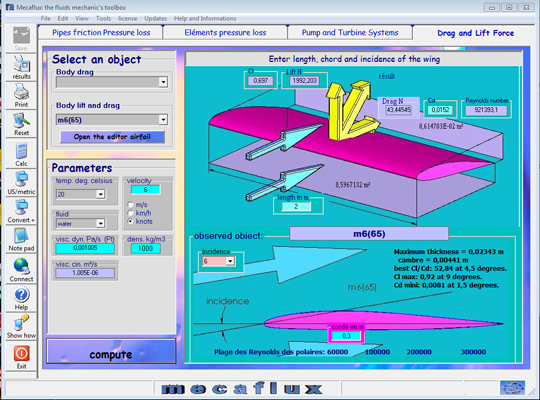
The drag force can be calculated from:
-
called a coefficient Cd (Cd is the drag coefficient, is determined experimentally in a wind tunnel)
- Fluid's speed,
- Fluid's density,
- and the reference surface, which may be different according to the object studied:
- The front surface (projection perpendicular to the flow) if the object is non-profiled, see: Midship area
- Wing area if the object is profiled, see: Wing area
with the drag formula:
p is the density of the fluid KG/m3
S front surface or Wing area m²
v the relative velocity* of the fluid m/s
*whether the fluid, the object, or both moving, we take into account the speed relative to each other..
Cd and Cl (drag and lift coefficient) measured experimentally are in the database, where the value of disks is always given as a function of the Reynolds number, which includes the fluid kinematic viscosity.
Methods or mathematical determination of Cd Cl exist, reaching levels of interesting information. The coefficients of drag and lift are often represented by graphs called Polars.
(In his profile editor mecaflux integrates Xfoil to determine the lift and drag profiles)
The drag force is expressed in Newtons, It is that which resists movement or slows down the ship.
The CD allows us to extrapolate the resistance to progress for a series of geometrically similar profiles. When the drag is studied in water we talk about viscous resistance: Rv and the formula for calculating the coefficient of viscous drag is related to the Reynolds number Re and takes the name of viscous drag coefficient: Cv Rv= Cv . (Re . K/L). rugosity(K) In naval hydrodynamics, sometimes a method method of dual models are used to determine the viscous resistance. With MECAFLUX standard Detail of the interface drag and lift calculation in MECAFLUX standard
